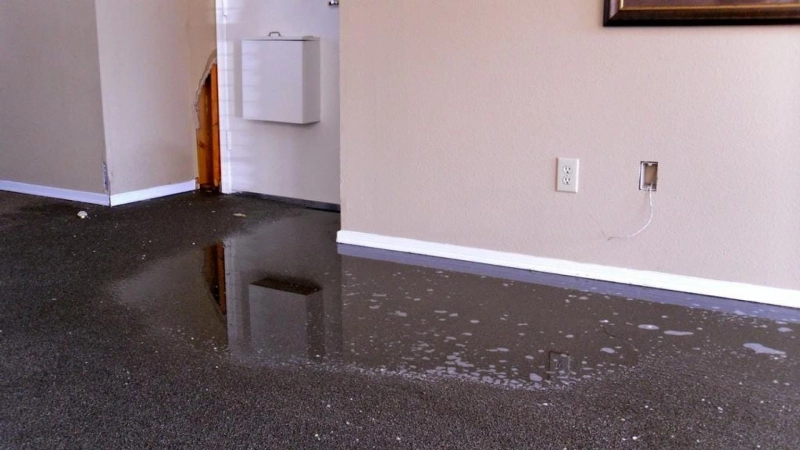Water damage threatens the integrity of your home or building through visible signs like staining and warping, as well as hidden dangers, including mold growth and structural weakening. Identifying these warning signs early allows you to address problems before they lead to disastrous structural failure. The most reliable indicators include musty odors, discolored walls or ceilings, peeling paint, warped materials, and visible mold growth.
Early detection saves thousands in repair costs—the average water damage restoration project ranges from $1,200 to $5,000, but structural repairs can exceed $10,000 when problems go unaddressed. This guide helps you identify warning signs, understand their severity, and know when to call professionals.
Visual Signs of Water Damage
Water leaves distinct traces throughout your structure that signal potential problems:
External Warning Signs
- Foundation cracks wider than 1/8 inch, especially horizontal ones
- Sagging rooflines or visible roof damage
- Exterior wall staining or efflorescence (white, powdery mineral deposits)
- Warped or rotting siding materials
- Pooling water near the foundation
Internal Warning Signs
- Ceiling discoloration or water spots
- Bubbling or peeling paint/wallpaper
- Warped or buckling flooring
- Visible mold patches on walls, ceilings, or corners
- Damp or musty odors
Bonus Tip: Examine baseboards and lower wall sections after heavy rainfall—these areas often show the first signs of foundation seepage or rising damp.

Structural Indicators of Serious Damage
According to industry data, buildings with untreated water damage lose approximately 20-30% of their structural strength within two years of continuous moisture exposure. Most concerning, 67% of severe structural failures develop from initially minor water infiltration issues.
Testing Methods for Confirmation
Confirm suspected water damage using these methods:
- Moisture meter readings above 16% indicate problematic moisture levels
- Infrared thermal imaging reveals temperature differentials from moisture
- Wooden probe test to check for softening in suspect areas
- Humidity measurements consistently above 60% suggest active moisture issues
Things to Consider Before Making a Decision
Before addressing suspected water damage, evaluate these factors:
- Damage timeline - Recent damage (under 48 hours) typically allows for simpler remediation
- Water classification - Clean water, gray water (washing machines/dishwashers), or black water (sewage/flooding) determine proper response protocols
- Insurance coverage - Review policy details for water damage coverage limitations
- Underlying cause - Temporary events (storm damage) versus ongoing issues (plumbing leaks) require different approaches
- Professional assessment - DIY evaluation misses 35% of serious hidden damage
Bonus Tip: Document all visible damage with dated photographs before repairs begin—this evidence proves invaluable for insurance claims.
Detecting Hidden Water Damage
Some of the most destructive water damage remains invisible without specialized detection:
Common Hidden Problem Areas
- Inside wall cavities - Often houses mold and rot without visible signs
- Beneath flooring - Subfloors absorb moisture, compromising structural integrity
- Within ceiling spaces- Water travels horizontally before creating visible ceiling stains
- Behind tile work - Especially in bathrooms and kitchens
- Crawlspaces and attics - Limited visibility areas prone to undetected damage
Professional Detection Tools
Professional inspectors use advanced equipment that provides definitive answers:
- Infrared cameras revealing temperature differentials
- Hygrometers measuring ambient moisture
- Borescope cameras for visual inspection of wall cavities
- Moisture meters for accurate material readings
- Air sampling for mold spore concentration
According to restoration industry statistics, professional inspections identify an average of 3.2 additional problem areas beyond those visible to homeowners.

Topic FAQ
How quickly can water damage compromise structural integrity?
Severe flooding can immediately compromise drywall and insulation, while wooden structural elements typically show degradation within 1-2 weeks of continuous moisture exposure. Concrete structures may withstand months of moisture but eventually deteriorate from internal reinforcement corrosion.
What's the difference between cosmetic and structural water damage?
Cosmetic damage affects appearance without threatening stability (surface staining or minor paint peeling). Structural damage compromises the building's integrity and safety through weakened support elements, rotted wood, or foundation undermining.
Can a structure recover from water damage without professional help?
Minor, recent water damage from clean sources can sometimes be addressed by thorough DIY drying within 24-48 hours. However, standing water, contaminated water, or damage affecting structural elements always requires professional assessment and remediation.
How do I distinguish between old and new water damage?
New water damage typically shows wet materials with sharp edges to stains, while old damage presents dry surfaces with defined rings, visible mold growth, and material degradation like peeling, flaking, or warping.
What humidity level indicates a potential moisture problem?
Indoor relative humidity consistently above 60% creates conditions for mold growth and indicates potential moisture sources. Ideal indoor humidity ranges between 30% - 50% to prevent moisture-related structural damage.
Protecting Your Investment
Water damage threatens both your structure's integrity and your financial investment. Early detection saves on average 65% in restoration costs compared to addressing advanced deterioration. Regular inspection of your property's vulnerable areas—particularly after severe weather—provides the best protection against catastrophic structural failures.
Remember that water damage compounds over time—what begins as a minor issue can rapidly escalate to major structural compromise within weeks or months. When in doubt, consult qualified professionals for water damage restoration who can accurately assess damage extent and provide appropriate remediation strategies.


